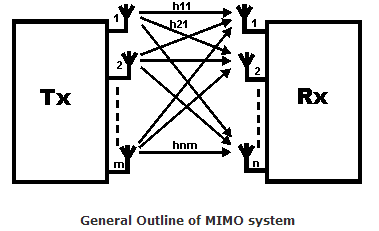MIMO: Multiple Input Multiple Output basics
A channel may be affected by fading and this will impact the signal to noise ratio. In turn this will impact the error rate, assuming digital data is being transmitted. The principle of diversity is to provide the receiver with multiple versions of the same signal. If these can be made to be affected in different ways by the signal path, the probability that they will all be affected at the same time is considerably reduced. Accordingly, diversity helps to stabilise a link and improves performance, reducing error rate.
Several different diversity modes are available and provide a number of advantages:
Time diversity: Using time diversity, a message may be transmitted at different times, e.g. using different timeslots and channel coding.
Frequency diversity: This form of diversity uses different frequencies. It may be in the form of using different channels, or technologies such as spread spectrum / OFDM.
Space diversity : Space diversity used in the broadest sense of the definition is used as the basis for MIMO. It uses antennas located in different positions to take advantage of the different radio paths that exist in a typical terrestrial environment.
MIMO is effectively a radio antenna technology as it uses multiple antennas at the transmitter and receiver to enable a variety of signal paths to carry the data, choosing separate paths for each antenna to enable multiple signal paths to be used.

One of the core ideas behind MIMO wireless systems space-time signal processing in which time (the natural dimension of digital communication data) is complemented with the spatial dimension inherent in the use of multiple spatially distributed antennas, i.e. the use of multiple antennas located at different points. Accordingly MIMO wireless systems can be viewed as a logical extension to the smart antennas that have been used for many years to improve wireless.
It is found between a transmitter and a receiver, the signal can take many paths. Additionally by moving the antennas even a small distance the paths used will change. The variety of paths available occurs as a result of the number of objects that appear to the side or even in the direct path between the transmitter and receiver. Previously these multiple paths only served to introduce interference. By using MIMO, these additional paths can be used to advantage. They can be used to provide additional robustness to the radio link by improving the signal to noise ratio, or by increasing the link data capacity.
The two main formats for MIMO are given below:
Spatial diversity: Spatial diversity used in this narrower sense often refers to transmit and receive diversity. These two methodologies are used to provide improvements in the signal to noise ratio and they are characterised by improving the reliability of the system with respect to the various forms of fading.
Spatial multiplexing : This form of MIMO is used to provide additional data capacity by utilising the different paths to carry additional traffic, i.e. increasing the data throughput capability.
As a result of the use multiple antennas, MIMO wireless technology is able to considerably increase the capacity of a given channel while still obeying Shannon's law. By increasing the number of receive and transmit antennas it is possible to linearly increase the throughput of the channel with every pair of antennas added to the system. This makes MIMO wireless technology one of the most important wireless techniques to be employed in recent years. As spectral bandwidth is becoming an ever more valuable commodity for radio communications systems, techniques are needed to use the available bandwidth more effectively. MIMO wireless technology is one of these techniques.
MIMO is used within LTE to provide better signal performance and / or higher data rates by the use of the radio path reflections that exist.
Multiple Input Multiple Output is another of the LTE major technology innovations used to improve the performance of the system. This technology provides LTE with the ability to further improve its data throughput and spectral efficiency above that obtained by the use of OFDM.
Although MIMO adds complexity to the system in terms of processing and the number of antennas required, it enables far high data rates to be achieved along with much improved spectral efficiency. As a result, MIMO has been included as an integral part of LTE.
LTE MIMO basics
The basic concept of MIMO utilises the multipath signal propagation that is present in all terrestrial communications. Rather than providing interference, these paths can be used to advantage.
MIMO is being used increasingly in many high data rate technologies including Wi-Fi and other wireless and cellular technologies to provide improved levels of efficiency. Essentially MIMO employs multiple antennas on the receiver and transmitter to utilise the multi-path effects that always exist to transmit additional data, rather than causing interference.
The schemes employed in LTE again vary slightly between the uplink and downlink. The reason for this is to keep the terminal cost low as there are far more terminals than base stations and as a result terminal works cost price is far more sensitive.
For the downlink, a configuration of two transmit antennas at the base station and two receive antennas on the mobile terminal is used as baseline, although configurations with four antennas are also being considered.
For the uplink from the mobile terminal to the base station, a scheme called MU-MIMO (Multi-User MIMO) is to be employed. Using this, even though the base station requires multiple antennas, the mobiles only have one transmit antenna and this considerably reduces the cost of the mobile. In operation, multiple mobile terminals may transmit simultaneously on the same channel or channels, but they do not cause interference to each other because mutually orthogonal pilot patterns are used. This techniques is also referred to as spatial domain multiple access (SDMA).
